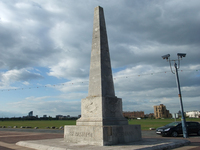- County name: Hampshire
- Group/School name: Portsmouth High School
- Age group: 11 - 18
- Group type: Secondary School
Staff at Portsmouth High School contacted War Memorials Trust through the First World War Centenary Partnership in 2013 to request a visit that would help pupils understand the work of the Trust and the importance of war memorials. The visit took place in January 2014.
During the morning that was spent at the school, the Trust’s Learning Officer gave an assembly to the whole school followed by lessons with Years 7 and 9. The school was keen that the assembly focus on the work of War Memorials Trust and so the Learning Officer explained when the charity was founded and why, and outlined the key aspects of the Trust’s work, including providing conservation advice in response to war memorial queries, offering financial assistance for the conservation and repair of war memorials through grant schemes, and educating young people about the importance of war memorials. War Memorials Trust believes it is important that young people engage with local war memorials and develop an understanding of our war memorial heritage and the importance of war memorials. The assembly also, therefore, outlined various ways the school’s pupils could get involved in the care and protection of their local war memorials, such as ensuring they are recorded on War Memorials Online (www.warmemorialsonline.org.uk) and being vigilant about their condition. The Trust is always pleased to know that young people are interested in their local war memorials and is always happy to provide further guidance on ways they can get involved with their war memorial heritage. Advice and project ideas are also given at www.learnaboutwarmemorials.org/youth-groups/projects.
Following the assembly the Trust’s Learning Officer worked with a group of Year 7 pupils. This lesson focused mainly on the history of war memorials and covered what war memorials are, why they exist and different types of war memorials. The pupils looked at a range of different war memorial pictures and were surprised at the range of designs that can be found in the UK. Because war memorials were erected by local communities without any rules or restrictions on their appearance or form, they vary enormously and pupils looked at some traditional types, such as monuments and crosses, and more unusual ones, such as framed paintings, buildings and landscaped features. Many were particularly interested in war memorials to groups other than people who served in war, such as civilians and animals. At the end of the lesson the class had a go at developing some initial ideas for if they were to design a war memorial now – the results were thoughtful and, in some cases, very original.
The last session of the morning’s visit was with a Year 9 class. Being slightly older these pupils already had a good understanding of the general history of war memorials and why they exist, so the lesson focused more on the changes to war memorials over time, and how the way conflicts have been commemorated has altered. This highlighted the First World War as something of a turning point in terms of memorialisation; there has never been that number of war memorials erected to commemorate one conflict, neither before nor since. As well as the scale of commemoration, the First World War saw a shift towards the individual commemoration of every person who lost their lives (and in some cases of every person who served). Prior to the twentieth century memorials tended not to list individual names in the way we tend to be familiar with today. This changed significantly after the First World War and the differences can often be clearly seen by comparing war memorials from different eras. The increase in less traditional war memorial designs can also be seen after the First World War and again after the Second World War.
There was also more of a focus in this session on local war memorials and Portsmouth examples, such as those shown in the photographs on this page, were used to illustrate the ideas being discussed where possible. Again this helps pupils to see the relevance of what they are learning about because it can be applied to their local area.
War Memorials Trust was pleased to work with Portsmouth High School and was delighted to see so many young people taking an interest in their local war memorial heritage. We hope that their enthusiasm continues through the First World War centenary and beyond.





